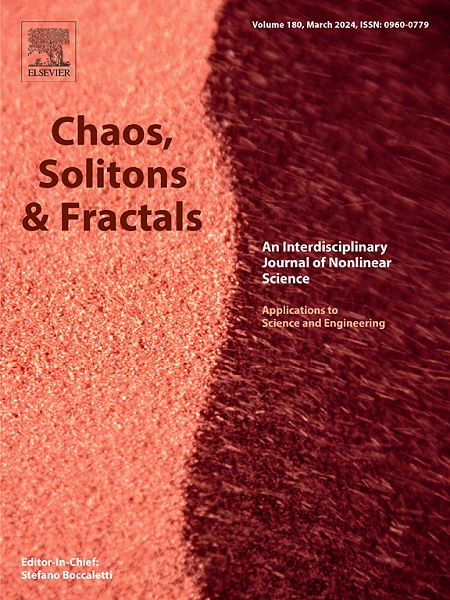Explosive synchronization driven by repulsive higher-order interactions in coupled neurons
IF 5.3
1区 数学
Q1 MATHEMATICS, INTERDISCIPLINARY APPLICATIONS
引用次数: 0
Abstract
Neuron synchronization plays a crucial role in brain dynamics. Although considerable progress has been made in the understanding of synchronization, the study in neuronal models within higher-order networks remains insufficiently understood. This study explores the impact of repulsive higher-order interactions in a weighted network of coupled Huber-Braun (HB) neurons, focusing on how these interactions influence the dynamics of synchronization and firing patterns. Our numerical simulations reveal that repulsive higher-order interactions can induce irreversible explosive transitions in synchronization, characterized by sudden and abrupt shifts in the network’s collective state. Additionally, with bifurcation diagrams and phase portraits, we also identify irreversible transitions in firing patterns, highlighting the presence of multistability within the system. Coexistence between dynamics is observed, such as period-1 and period-2 bursting, period-3 bursting and chaotic dynamics. These findings contribute to a deeper understanding of how higher-order interactions affect neuronal dynamics, offering insights into the mechanisms behind explosive synchronization and its implications for neural network behavior.
耦合神经元中排斥性高阶相互作用驱动的爆炸同步
神经元同步在脑动力学中起着至关重要的作用。尽管对同步的理解已经取得了相当大的进展,但对高阶网络中神经元模型的研究仍然知之甚少。本研究探讨了在耦合Huber-Braun (HB)神经元加权网络中排斥性高阶相互作用的影响,重点关注这些相互作用如何影响同步和放电模式的动态。我们的数值模拟表明,排斥性高阶相互作用可以诱导不可逆的同步爆炸转变,其特征是网络集体状态的突然和突变。此外,通过分岔图和相肖像,我们还确定了发射模式中的不可逆转变,突出了系统中多稳定性的存在。观察到周期1和周期2爆破、周期3爆破和混沌动力学共存。这些发现有助于更深入地了解高阶相互作用如何影响神经元动力学,为爆炸性同步背后的机制及其对神经网络行为的影响提供见解。
本文章由计算机程序翻译,如有差异,请以英文原文为准。
求助全文
约1分钟内获得全文
求助全文
来源期刊

Chaos Solitons & Fractals
物理-数学跨学科应用
CiteScore
13.20
自引率
10.30%
发文量
1087
审稿时长
9 months
期刊介绍:
Chaos, Solitons & Fractals strives to establish itself as a premier journal in the interdisciplinary realm of Nonlinear Science, Non-equilibrium, and Complex Phenomena. It welcomes submissions covering a broad spectrum of topics within this field, including dynamics, non-equilibrium processes in physics, chemistry, and geophysics, complex matter and networks, mathematical models, computational biology, applications to quantum and mesoscopic phenomena, fluctuations and random processes, self-organization, and social phenomena.
 求助内容:
求助内容: 应助结果提醒方式:
应助结果提醒方式:


